The Henfield Swift Project was set up in 2017 with Debbie Colgate as the local ‘Swift Champion’. Her role is to engage with local residents to tell them about Swifts – the main problems faced by them and how we, in Henfield, can help them.
Let’s start with some basics, what is a Swift? It is a member of the Apodidae family and migrates up from Southern Africa each year to breed. If you live in Henfield you have probably seen and heard them screaming as they fly up the High Street.
Listen to the sound of Swifts in flight
These birds are amazing!
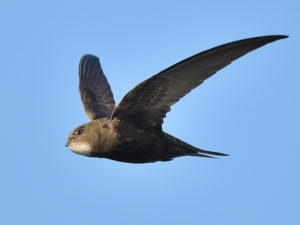
Did you know?
- They can fly up to 500 miles a day in search of food.
- They can fly 2 million miles in a lifetime – that’s the equivalent of flying to the moon and back over 4 times. That figure includes the 14,000 miles they fly migrating from Mozambique each year.
- Their highest speed recorded is 67.5mph
- They fly as high as 3,000 metres
- They mate for life
In Trouble
Sadly though, swifts are in trouble with their breeding numbers plummeting. There has been a 51% drop in their breeding numbers in the UK between 1995 and 2015, that’s in just 20 years, and they are now an amber listed species. There are several reasons for this decline, the most significant of which is the loss of their nesting habitat.
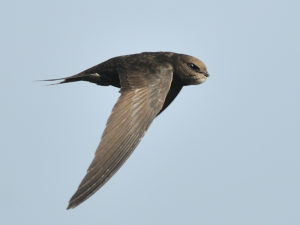
Swifts normally arrive in the UK in the middle of May and they generally leave at the end of July. Other migrant birds will have arrived earlier and leave us later in the year. This gives them time to stake their territories and build their nests and they will have laid eggs by the middle of May (when Swifts are just arriving) and, if the first brood fails they have time to try again. Swifts don’t have that luxury, they only have 2 and a half months to nest, lay eggs, brood them and raise their young so they don’t have time to look around for a nest site and build a nest.
Because of this, they are very faithful to their existing nest so that they can start mating as soon as they arrive.
They nest in old buildings, in nooks and crannies – any small hole or gap that they can get into. But we repair old buildings or we knock them down! New and repaired buildings don’t have nooks and crannies, small holes or gaps. So when the Swifts, who are very faithful to their existing nesting sites, arrive back from Africa to raise a new family, they find their nesting sites have gone and they are HOMELESS!
Help
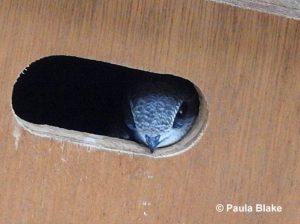
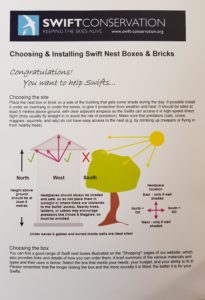
So how can we help? We can provide them with nest sites by putting up specifically designed and durable Swift boxes that have been proven to provide a stable nest site and we won’t let anyone interfere with them.
Swifts live in colonies and birds coming up to sexual maturity will look for breeding places already established by other Swifts, so the best way to attract them to a new nest site is to play Swifts calls.
It can be a drawn out process – back in 2006 Henfield Birdwatch had a look at Swifts and decided to put up 4 Swift boxes on the side of Stokes in the High Street and waited and waited. It has taken 12 years for Swifts to start having a look at them.
Some Swifts were seen towards the end of July 2018 flying up and looking at the boxes and going into them. These would have been juvenile birds that are reaching their sexual maturity and are looking at suitable nesting sites for 2019.
The Birdwatch committee had thought about taking the boxes down and re-siting them – thank goodness we didn’t! We had our fingers crossed that the Swifts would come back in 2019 and start to use the boxes and they did!!
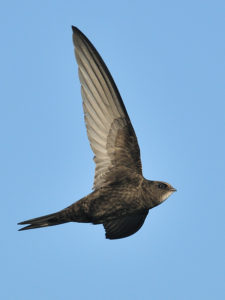
In 2008 one of our members noticed Swifts flying around her house. She arranged for a Swift box to be put up and the birds showed immediate interest. Over the years she has had 3 more boxes put up and Swifts have used the boxes to raise their broods.
Debbie herself put up two Swift boxes up in the winter of 2016. They were put in the ideal position of a north facing site and far enough off the ground with good access to leave them enough space to zoom up into the box at 40 miles an hour. In May 2017 she used an MP3 player to play Swift calls from the end of her garden and was rewarded with a pair of Swifts using one of the boxes.
Download further information about how to attract Swifts by playing recordings of calls.
So far 20 Henfield residents have asked Birdwatch to put Swift boxes on their houses. Everyone is very grateful to the Henfield Shed which has made all these boxes and has offered to continue to make Swift boxes for us in the future. This has become a real “community” project.
So that’s some good news about existing buildings, but it doesn’t have to stop there. It looks as if we are going to have a lot of new builds in the future. What about them? Around the country small organisations like Henfield Birdwatch are successfully talking to and encouraging house builders to put Swift bricks in their new builds. Swift bricks look like an ordinary brick, with a small hole for the bird to enter, but internally there is a chamber where the birds can lay eggs and raise their young. Henfield Birdwatch will ensure that, in the future, those companies building new houses in Henfield will be educated and encouraged to provide these birds with nesting sites.
2019 Update
By spring 2019, a further 17 boxes were installed on private houses. 15 of these were on houses that had not previously had boxes on them – virgin sites!
The owners of these houses were advised to play Swift calls to attract the birds and we all waited with baited breath……

Now you have to be patient with Swifts. Those sexually mature birds that have previously nested in this country will return to that existing site until such time as they die or the site is disturbed. New sites will only be used by Swifts as they sexually mature and this takes them several years. This means that new sites are looking to attract sexually immature swifts that MAY BE looking for a nesting site FOR THE FOLLOWING YEAR.
During summer of 2019 Birdwatch members looked out for Swifts to see whether they were using the old and new boxes. It became apparent that 6 of the boxes at Stokes and Henfield Club were being used. There were more natural nest sites being used also – there were now 2 nests at Henfield Galleries, 1 at Hartleys Off Licence and 1 at KT Nails.
Of the 17 new boxes interest was shown in 10 of them, though none were used for nesting purposes. Unfortunately a few boxes were used by Starlings.
As I advised earlier in this report we were aware of 5 active Swift nests in Henfield prior to Spring 2019. By the end of Summer 2019 we were able to identify 16 active Swift nests. Obviously this increase isn’t due to the Swift Project however the Project has raised this bird’s profile amongst Henfield residents which can only be a good thing. The Project has actively increased the number of permanent nest sites which, I hope, will lead to an increased Swift population in the future.
We will continue to survey these wonderful birds throughout the coming years and I hope that we can continue to support them and make Henfield a good place for them.
More Information
If you’d like any more information please contact Debbie at henfieldswifts@henfieldbirdwatch.co.uk